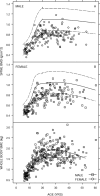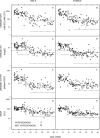Bone disease in thalassemia: a frequent and still unresolved problem
- PMID: 18505376
- PMCID: PMC3276604
- DOI: 10.1359/jbmr.080505
Bone disease in thalassemia: a frequent and still unresolved problem
Abstract
Adults with beta thalassemia major frequently have low BMD, fractures, and bone pain. The purpose of this study was to determine the prevalence of low BMD, fractures, and bone pain in all thalassemia syndromes in childhood, adolescence, and adulthood, associations of BMD with fractures and bone pain, and etiology of bone disease in thalassemia. Patients of all thalassemia syndromes in the Thalassemia Clinical Research Network, > or =6 yr of age, with no preexisting medical condition affecting bone mass or requiring steroids, participated. We measured spine and femur BMD and whole body BMC by DXA and assessed vertebral abnormalities by morphometric X-ray absorptiometry (MXA). Medical history by interview and review of medical records, physical examinations, and blood and urine collections were performed. Three hundred sixty-one subjects, 49% male, with a mean age of 23.2 yr (range, 6.1-75 yr), were studied. Spine and femur BMD Z-scores < -2 occurred in 46% and 25% of participants, respectively. Greater age, lower weight, hypogonadism, and increased bone turnover were strong independent predictors of low bone mass regardless of thalassemia syndrome. Peak bone mass was suboptimal. Thirty-six percent of patients had a history of fractures, and 34% reported bone pain. BMD was negatively associated with fractures but not with bone pain. Nine percent of participants had uniformly decreased height of several vertebrae by MXA, which was associated with the use of iron chelator deferoxamine before 6 yr of age. In patients with thalassemia, low BMD and fractures occur frequently and independently of the particular syndrome. Peak bone mass is suboptimal. Low BMD is associated with hypogonadism, increased bone turnover, and an increased risk for fractures.
Figures





 ; 20 or more yrs, •). Point estimates and exact 95% confidence intervals are indicated.
; 20 or more yrs, •). Point estimates and exact 95% confidence intervals are indicated.References
-
- Weatherall DJ. Phenotype-genotype relationship in monogenic disease: Lessons from the thalassemias. Nat Rev. 2001;2:245–255. - PubMed
-
- Calleja E, Shen JY, Lesser M, Grady RW, New MI, Giardina PJ. Survival and Morbidity in Transfusion Dependent Thalassemia Patients on Subcutaneous Desferrioxamine Chelation: Nearly Two Decades of Experience. NY Acad Sci. 1998;850:469–470. - PubMed
-
- Ehlers KH, Giardina PJ, Lesser ML, Engle MA, Hilgartner MW. Prolonged survival in patients with beta-thalassemia major treated with deferoxamine. J Pediatr. 1991;118:540–545. - PubMed
-
- Cooley TB, Lee P. A series of cases of splenomegaly in children with anemia and peculiar bone changes. Trans Am Pediatr Soc. 1925;37:29–30.
-
- Wolman IJ, Ortalani M. Some clinical features of Cooley's anemia patients as related to transfusion schedules. Ann NY Acad Sci. 1969;105:407. - PubMed
Publication types
MeSH terms
Substances
Grants and funding
- U01-HL-65260/HL/NHLBI NIH HHS/United States
- 5K24HL004184-08/HL/NHLBI NIH HHS/United States
- K24 HL004184/HL/NHLBI NIH HHS/United States
- M01-RR02172/RR/NCRR NIH HHS/United States
- K08 HL088231/HL/NHLBI NIH HHS/United States
- U01 HL065238/HL/NHLBI NIH HHS/United States
- U01-HL-65238/HL/NHLBI NIH HHS/United States
- U01 HL065260/HL/NHLBI NIH HHS/United States
- U01 HL065239/HL/NHLBI NIH HHS/United States
- UL1-RR024134/RR/NCRR NIH HHS/United States
- U01 HL065232/HL/NHLBI NIH HHS/United States
- UL1 RR024134/RR/NCRR NIH HHS/United States
- U01-HL-65232/HL/NHLBI NIH HHS/United States
- 44917/CAPMC/ CIHR/Canada
- U01 HL065244/HL/NHLBI NIH HHS/United States
- U01 HL065233/HL/NHLBI NIH HHS/United States
- U01-HL-65239/HL/NHLBI NIH HHS/United States
- M01 RR002172/RR/NCRR NIH HHS/United States
- U01-HL-65244/HL/NHLBI NIH HHS/United States
- U01-HL-65233/HL/NHLBI NIH HHS/United States
LinkOut - more resources
Full Text Sources
Other Literature Sources
Medical

